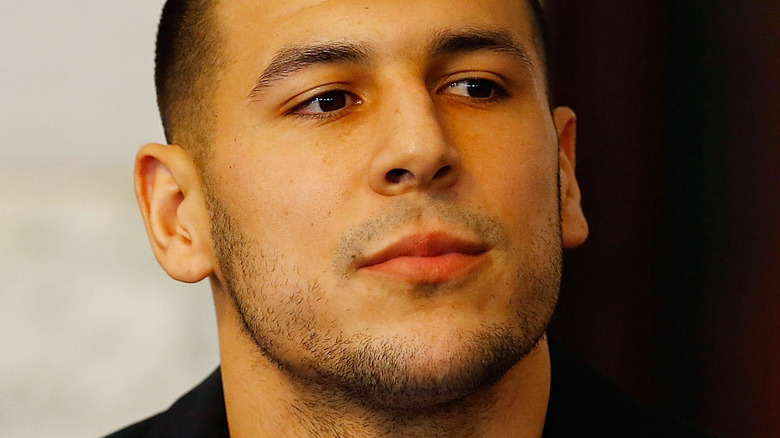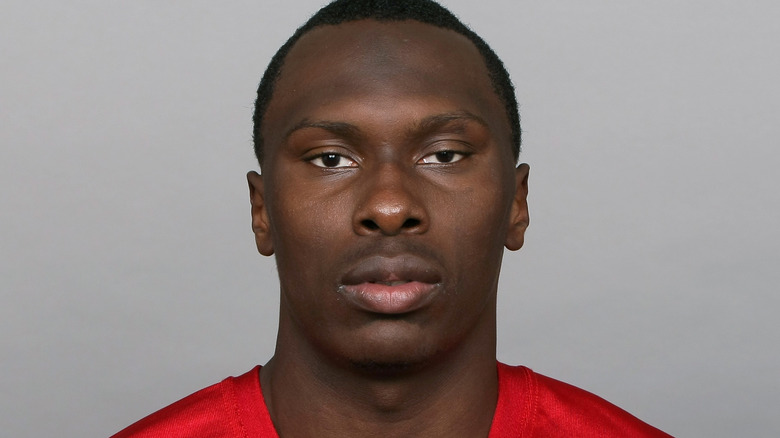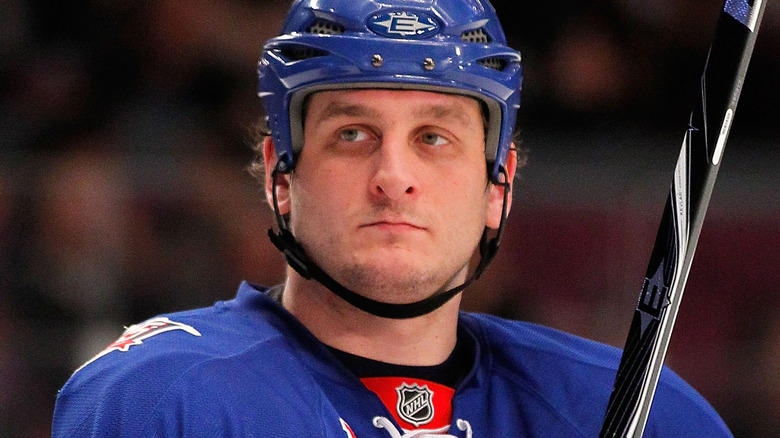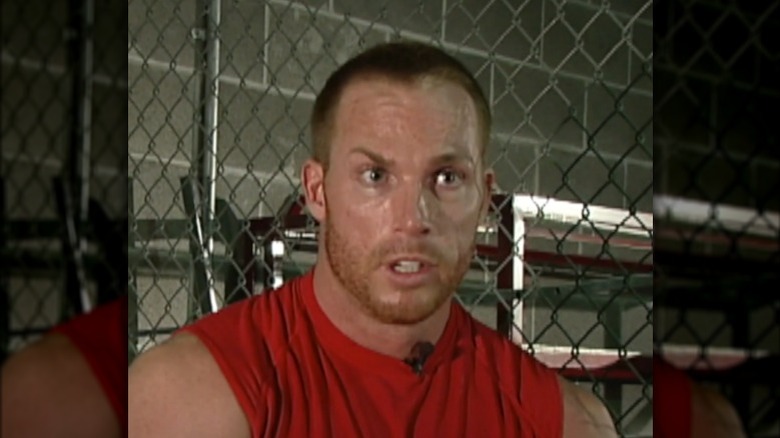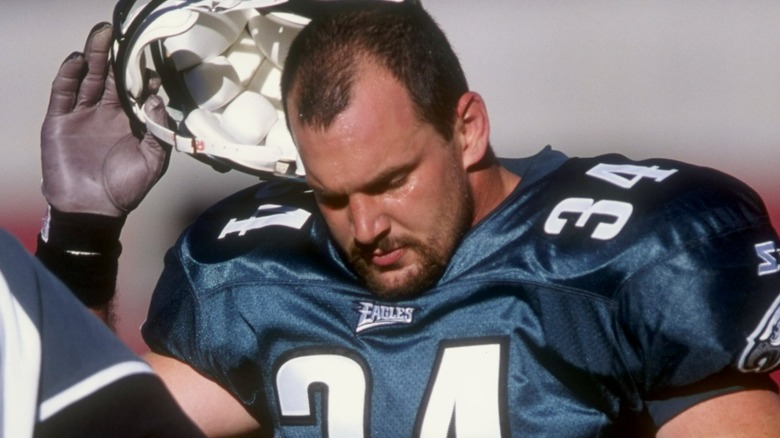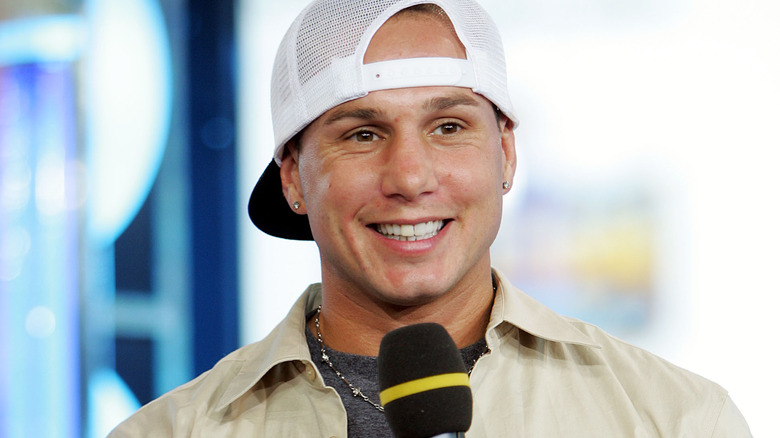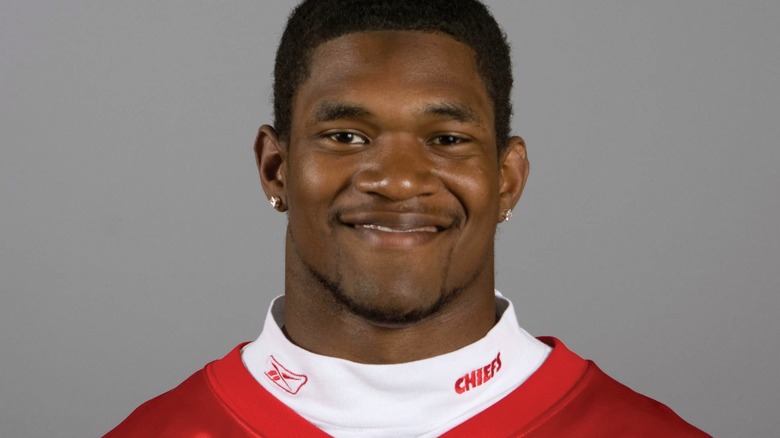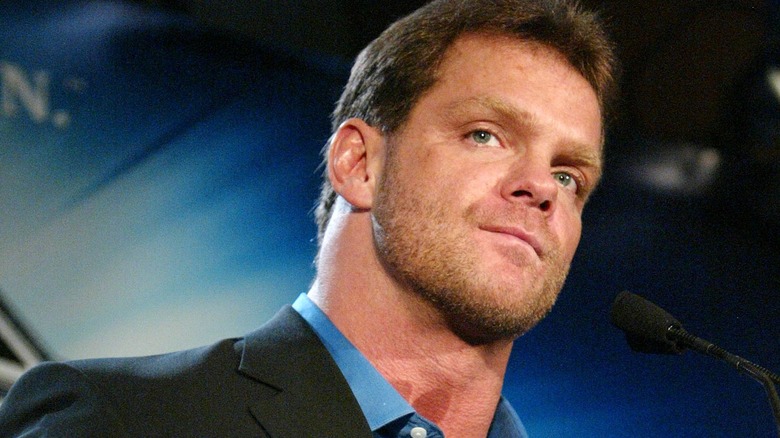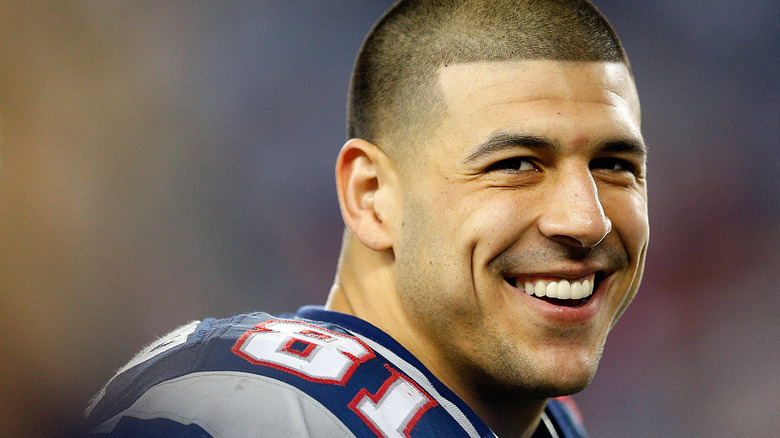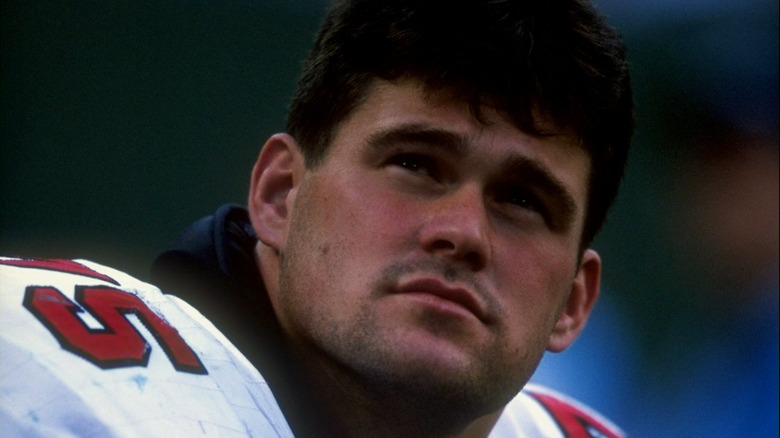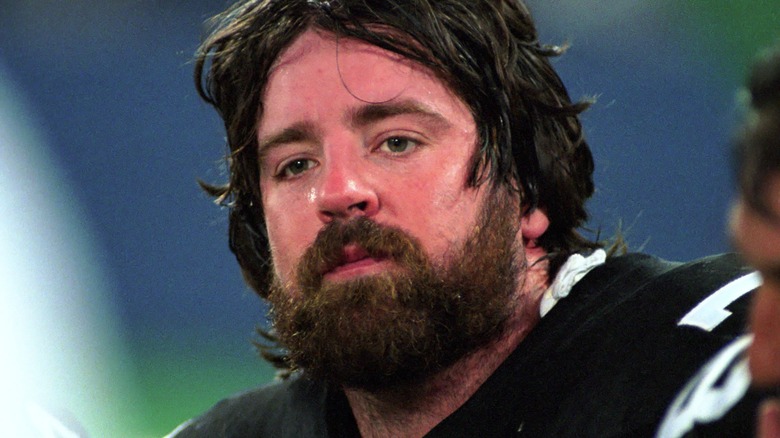The Chilling Connection Between All These Athletes That Died Young
The following article contains references to murder, suicide, and addiction.
Celebrity deaths affect us in manifold complex ways, and many fans grieve the passing of a beloved celeb as they would a family member. In part, this has been attributable to what psychologist Hvovi Bhagwagar terms the "immortal" star, a belief that "celebrities don't necessarily follow typically understood measures of time and space ... So, when they pass away, we can't connect to their deaths in reality," as Bhagwagar explained to Vice. But when a celebrity dies young, it triggers a particular poignancy, as one can't help but ruminate on what might have been.
For instance, Kobe Bryant's death at the tender age of 41 was especially distressing. But the circumstances of Bryant's passing, while extremely tragic, at least provided fans with some closure. Sometimes, however, athletes' deaths have been perplexing, often offering more questions than answers.
In the case of the following sports stars, there was a distinct change in their behavior in the lead-up to their deaths. Friends and family noticed that many of these athletes became mere shells of their former glory, often exhibiting worrying symptoms. Eerily, a number of them even predicted or hinted at their untimely deaths. Moreover, it seems unfathomable that the sports they loved, which propelled them towards stardom and prosperity, may have somehow been responsible for their downfalls. Whether confirmed or speculative, a mysterious ailment was believed to have played a role in the premature deaths of the following athletes. This is the chilling connection between all these athletes that died young.
Cornerback Phillip Adams' chilling final moments
Phillip Adams was an NFL mainstay for half a decade, racking up a combined 78 appearances for several of the biggest teams in the league, including the San Francisco 49ers and the Oakland Raiders. But one fateful day in the spring of 2021 would forever alter his public image.
On April 7, 2021, six people were shot and killed in York County, South Carolina. The suspect was later named as Adams, who then killed himself, per The Charlotte Observer. He was just 32. As noted by The New York Times, Adams shot his doctor, Robert Lesslie, along with the physician's wife and two grandchildren, leaving both investigators and Adams' family and friends puzzled due to the NFL star's mild demeanor and lack of any prior criminal history.
However, Adams' sister, Lauren, has shed some light on his health leading up to the incident. "His mental health degraded fast and terribly bad,” Lauren told USA Today. "There was unusual behavior. ... that was not like we had ever seen." Lauren emphasized that Adams' violent final act shouldn't tarnish his impressive legacy, suggesting that something out of his control may have caused his sharp decline. "He wasn't a monster," she insisted.
In December 2021, a post-mortem revealed that Adams had "unusually severe" C.T.E. (chronic traumatic encephalopathy), a form of brain damage linked to repeated head trauma, as per The New York Times. Dr. Ann McKee said that C.T.E. "might have contributed to Adams's behavioral abnormalities."
If you or anyone you know is having suicidal thoughts, please call the National Suicide Prevention Lifeline at 1-800-273-TALK (8255).
The haunting last words of Daffney
In the male-dominated world of wrestling, Daffney (born Shannon Spruill) wasn't afraid to mix it up with the men. She often competed in mixed-gender matches, winning the men's WCW Cruiserweight title. Ultimately, this came at a cost to her health. Daffney suffered from persistent and debilitating headaches, believed to be the result of multiple concussions. "It would be like her brain was so messed up that if she was looking at the phone screen she would have to put a blanket over her windows and have the lights off because she would get headaches," fellow wrestler Jamie Lynn Senegal told USA Today.
In September 2021, Daffney did an Instagram Live stream, where she was seen brandishing a gun and appearing agitated. Shortly after the stream, TMZ reported that she had died by suicide, aged 46.
Daffney's live stream, filmed mere moments before her death, demonstrates her firm belief that she had C.T.E., which may have been responsible for her frequent headaches. "The most important thing to remember is that C.T.E. and head injuries and concussions ... They can now really only be diagnosed after you are dead," she said in the video, per People. "So, I don't want to do anything to hurt my brain. I want to be studied." While it has not been confirmed whether Daffney did have C.T.E., some of the last words she uttered remain a stark reminder of the pain seemingly inflicted upon her by her profession.
If you or anyone you know is having suicidal thoughts, please call the National Suicide Prevention Lifeline at 1-800-273-TALK (8255).
Did hockey play a role in Derek Boogaard's early demise?
It was the irascible nature of ice hockey star Derek Boogaard that first endeared scouts towards him. At the age of 15, Boogaard was participating in a hockey match when he began swinging at his opponents, as chronicled by The New York Times. This display of bravado impressed scouts for the Regina Pats, who watched from the sidelines, and he was subsequently offered a life-changing career opportunity, eventually leading to his stint with the New York Rangers.
But while these outbursts were the catalyst for Boogaard's professional hockey career, they were also his downfall. As the New York Post highlights, his mantra was "Live by the sword, die by the sword," reflective of his innumerable hockey fights. A profile by The New York Times illustrates that Boogaard began suffering from severe headaches to the point of nausea and intolerance to light. Subsequently, his professional career had to be put on hold. This, his friends have stated, caused him to become deeply depressed. Tragically, at the tender age of 28, he died in 2011, the result of an accidental overdose.
Following Boogaard's untimely demise, his family sought answers, and a brain analysis was conducted. Their worst fears were confirmed when it was announced that he had C.T.E. caused by persistent head trauma due to hockey, per The New York Times. Had he not suffered that fatal drug overdose, doctors predicted that Boogaard would have developed dementia by the time he reached middle age.
If you or anyone you know is struggling with addiction issues, help is available. Visit the Substance Abuse and Mental Health Services Administration website or contact SAMHSA's National Helpline at 1-800-662-HELP (4357).
No one knew how ill Andrew Martin was until he died
Andrew Martin, better known by his in-ring name Test, found fame as a mid-card wrestler in the WWE during the company's ascendency to the mainstream at the turn of the millennium. Best known as a tag-team wrestler, he was famed for his stature and strength in the ring. However, during this time, the wrestling biz was rocked by the deaths of several notable athletes, including Russ Haas and Eddie Guerrero.
Reflecting on the premature deaths of so many of his peers, Martin's words were eerie and foreboding. "I've just turned 32 years old and I've been to eight funerals this year," he said in a 2007 interview for a documentary, per Wrestling News Source. "I shouldn't be going to funerals at 32 years old. ... it opened my eyes and made me take my foot out of the grave. It made me ask: 'What am I doing? Do I want to join that club?'"
Tragically, Martin did join that club when he died almost a year and a half later. The Sun notes that the 33-year-old died of an accidental overdose, but his autopsy ultimately revealed something else. Dr. Bennet Omalu told ESPN that Martin's post-mortem examination showed signs of C.T.E., which elucidated his sudden change of character. "When I talked with his parents, they confirmed manic depressive behavior," Omalu explained. "They said he just couldn't cope. They didn't think it was their son. They didn't understand what had happened. Andrew Martin manifested symptoms of C.T.E. That's what happened."
If you or anyone you know is struggling with addiction issues, help is available. Visit the Substance Abuse and Mental Health Services Administration website or contact SAMHSA's National Helpline at 1-800-662-HELP (4357).
Kevin Turner died of ALS, but his post-mortem revealed something else
NFL fullback Kevin Turner had an impressive professional record, playing for the Philadelphia Eagles and New England Patriots. However, a number of injuries forced him to retire in 1999, per AL.
In 2010, Turner was diagnosed with the degenerative disease amyotrophic lateral sclerosis, and he died six years later at the age of 46. ESPN reports that Turner hypothesized that his condition may have been linked to C.T.E., both of which he believed were caused by head injuries during his footballing career. Subsequently, he donated his brain in the hope of aiding head trauma studies following his death. Sadly, Turner admitted that he would not have pursued an NFL career had he known of the potentially devastating ramifications. "Football had something to do with it. ... If they would have come to me and said, 'I've seen the future. This is what happens,' of course, I would stop playing immediately," he revealed.
After conducting an analysis on Turner's brain, The Boston University School of Medicine concluded that the football player had advanced C.T.E. What's more, the condition appeared to have caused his ALS. "The severity of Mr. Turner's C.T.E. was extraordinary and unprecedented for an athlete who died in his 40s," researcher Ann McKee said. "While he had typical cognitive symptoms and problems with impulse control associated with C.T.E., it also appears that C.T.E. decimated the motor cortex of his brain at a young age, likely leading to his ALS symptoms."
Chris Henry's shift in behavior before his death
Chris Henry was a talented wide receiver for the Cincinnati Bengals, with an impressive career record. But the young sportsman's NFL career was cut short after just four years. As chronicled by Bleacher Report, the Bengals decided to cut Henry from the team following some legal issues. However, he was given a second chance, one he was determined not to blow. Thereafter, Henry's teammate Carson Palmer noted his renewed commitment to the game. "He's a great kid with a great heart," Carson said, per HuffPost. "He's changed his life around. ... and has done everything he can to make himself a better person."
But things took a turn for the worse a week before Christmas 2009. Following a dispute with his fiancée, Henry fell out the back of a pickup truck, resulting in catastrophic injuries, as reported by HuffPost. He died the next day, aged 26.
The circumstances surrounding Henry's death remain mysterious. That tragic day continues to baffle his fiancée, Loleini Tonga, who told ESPN that Henry was not trying to die when he threw himself out of the pickup truck she was driving. A C.T.E. diagnosis in 2010 may help to explain his poor impulse control, but, as Dr. Julian Bailes told The New York Times, unlike many of his fellow athletes who died with C.T.E., Henry did not have a history of concussions. "Is there some lower threshold when you become at risk for this disease?" Bailes pondered.
If you or someone you know is struggling with mental health, please contact the Crisis Text Line by texting HOME to 741741, call the National Alliance on Mental Illness helpline at 1-800-950-NAMI (6264), or visit the National Institute of Mental Health website.
Dave Mirra had a history of brain injuries
Dave Mirra was a BMX icon, but his passion for the sport would ultimately spell his downfall. As he prophetically once said (via Rolling Stone), "They'll die. Just like I would when I was younger. I would have died to win." Mirra died to win, but he also lived to win, so when his career came to an end, he struggled with the aftermath of a life without extreme sports. Friends told TMZ that Mirra "couldn't find anything in his life to even approximate the adrenaline rush he got from BMX."
Subsequently, Mirra died by suicide in 2016. He was just 41. Those who saw Mirra in his final months expressed their concern for his seemingly deteriorating state, with Rolling Stone describing him as "stuck on one topic, returning to it again and again, forgetting what he'd just said. ... emotionally fragile, breaking into tears in the middle of everyday conversation."
Throughout his short lifetime, Rolling Stone notes that Mirra suffered several potentially fatal injuries, including a 16-foot fall in 2006 and a 14-foot fall a number of years later, resulting in the athlete "momentarily losing consciousness." So, when Mirra died, his C.T.E. diagnosis came as little surprise. "It's assumed it is related to multiple concussions that happened years before," Dr. Lili-Naz Hazrati told ESPN. Mirra's widow, Lauren, confirmed to the publication that he had grown increasingly unrecognizable in his final days. "He was lost," she poignantly revealed.
If you or anyone you know is having suicidal thoughts, please call the National Suicide Prevention Lifeline at 1-800-273-TALK (8255).
Jovan Belcher's devastating final hours
NFL star Jovan Belcher appeared to have it all: a glittering career as a linebacker with the Kansas City Chiefs, a $1.9 million contract, and a loving girlfriend and baby daughter. However, the seemingly perfect life of the football player began to unravel amid a shocking display of violence. In 2012, Belcher shot his long-term girlfriend, Kasandra Perkins, following an argument. As The Kansas City Star reports, Belcher apologized to Perkins as she lay dead, confessed to the police, and then turned the gun on himself. He was just 25.
Friends of the late star have struggled to fathom why someone they knew and loved, someone who appeared so placid and amiable, could commit such a horrific act of violence. "We used to do these school visits, and Jovan would just light up around kids," a Chiefs employee, Josh Looney, told Bleacher Report. Inexplicably, this was the same man who went on to murder the mother of his child. Another pal, Thomas Jones, told the outlet, "I loved him ... But what he did was a horrible, horrible act. There's no getting around that."
At the request of his family, desperate for answers, Belcher's body was exhumed a year later. Dr. Bennet Omalu, who also examined wrestler Andrew Martin, told USA Today that he "would bet one month's salary that (Belcher) had C.T.E." ESPN reports that doctors did find signs of C.T.E. upon analysis of Belcher's brain, hopefully providing his family with some much-needed answers.
If you or anyone you know is having suicidal thoughts, please call the National Suicide Prevention Lifeline at 1-800-273-TALK (8255).
A grisly discovery after Chris Benoit's death
The death of wrestling superstar Chris Benoit shocked the world. An icon within the WWE, no one expected Benoit's life and career to end in such a harrowing way. When the 40-year-old was found dead by suicide in 2007, police soon made a chilling discovery: Benoit had also killed his wife and 7-year-old son. The tragedy left the wrestling world aghast, as both fans and peers struggled to fathom what had occurred, with a stunned Hulk Hogan telling Us Magazine that Benoit was a "peaceful" person.
However, Benoit's co-workers had noticed a recent shift in his behavior, as he appeared obsessed with proving his worth in the ring, which led to some extremely dangerous stunts. "One time I was watching Chris fight and he allowed someone to hit him on the back of the head with a chair," fellow wrestler Christopher Nowinski told The Guardian, adding, "It was a really bad idea in terms of brain trauma. Chris always wanted it to look realistic." Accordingly, in the lead-up to that nightmarish day, Nowinski observed "signs of strange behavior. He was depressed, becoming paranoid. These are issues we've seen in other athletes who've suffered head traumas."
Post-mortem analysis found that "Benoit's brain was so severely damaged it resembled the brain of an 85-year-old Alzheimer's patient," as noted by ABC News. "It was extensive throughout Chris' brain," Dr. Julian Bailes told ABC. "This is something you should never see in a 40-year-old."
If you or anyone you know is having suicidal thoughts, please call the National Suicide Prevention Lifeline at 1-800-273-TALK (8255).
Aaron Hernandez was shunned before his death, but all was not as it seemed
NFL star Aaron Hernandez appeared to have it all. After signing with the New England Patriots, he was awarded a contract that would see him earn $40 million. Why, then, would such a gifted and financially privileged athlete commit a violent act that would not only end his career but forever tarnish his reputation?
In the summer of 2013, Hernandez was arrested and charged with the murder of his friend, Odin Lloyd, per the Boston Globe. Lloyd had been killed a week earlier near Hernandez's mansion. To make matters worse, police then began investigating the NFL star's possible roles in a 2007 double shooting and a 2012 drive-by shooting. Hernandez was found guilty of murdering Lloyd and sentenced to life in prison, though he was acquitted of double murder in the 2012 shooting. The Hernandez case remains bizarre as to why a man who had everything would throw it all away over a dispute with an ex-pal.
In 2017, Hernandez died by suicide in his prison cell. He was 27. Following his death, medical examiners confirmed that Hernandez had what The Washington Post terms "the most severe case of chronic traumatic encephalopathy ever discovered in a person his age." Dr. Ann McKee told the outlet that the diagnosis may help to explain Hernandez's uncharacteristic behavior: "Individuals with C.T.E. ... of this severity have difficulty with impulse control, decision-making, inhibition of impulses for aggression, emotional volatility, rage behaviors."
If you or anyone you know is having suicidal thoughts, please call the National Suicide Prevention Lifeline at 1-800-273-TALK (8255).
Shane Dronett experienced mysterious symptoms when he retired
Defensive lineman Shane Dronett made an impressive 139 NFL appearances over a 10-year period, playing for renowned teams such as the Denver Broncos and Atlanta Falcons. But his career, while undeniably formidable, was blighted by frequent injuries. Although he signed a $20 million contract in 2000, Pro Football Weekly wrote at the time that a spate of injuries had a major impact on his career.
Once a congenial and easy-going man, friends and family began to see a marked difference in Dronett's demeanor. "He woke up in the middle of the night and started screaming and told everyone to run out of the house," his wife, Chris, told CNN. "He thought that someone was blowing up our house. It was very frightening." The publication notes that the athlete was beset by paranoia, instability, and recurrent night terrors. Then, one winter's day in 2009, he brandished a gun in front of his wife. "I saw the gun, and I ran out the front door," Chris continued. "He had gone into the kitchen, and as soon as I put my hand on the front door, I heard it." Dronett was just 38 when he died.
As CNN reports, Dronett's post-mortem examination revealed evidence of C.T.E. "He thought everyone was turning against him," Chris told Beaumont Enterprise, adding that, while her late husband's C.T.E. diagnosis may help to decipher his paranoia, "None of us ... will ever have complete closure."
If you or anyone you know is having suicidal thoughts, please call the National Suicide Prevention Lifeline at 1-800-273-TALK (8255).
The tragic last days of Vincent Jackson
Vincent Jackson, a wide receiver for the San Diego Chargers and Tampa Bay Buccaneers, was much loved during his all too brief lifetime. When he was found dead at the age of 38 in 2021, tributes poured in from both fans and fellow athletes alike. Pewter Report outlined that chronic alcoholism played a role in the sportsman's untimely death, and, eventually, a post-mortem examination of Jackson's brain revealed that he had stage 2 C.T.E.
"Vincent Jackson was a brilliant, disciplined, gentle giant whose life began to change in his mid-30s," C.T.E. expert Dr. Ann McKee stated, as per The Athletic. "He became depressed, with progressive memory loss, problem solving difficulties, paranoia, and eventually extreme social isolation."
Jackson's decline remains a stark reminder that riches and fame do not guarantee health and longevity. "His whole plan in the N.F.L. was to set himself up to not have these struggles," his wife, Lindsey, told The New York Times in a heartbreaking interview. "It's not the ending he wanted." But, as Lindsey went on to highlight, neither she nor her husband knew about the potentially deadly ramifications of repeated concussions. "I think the message is, if you played for a long time and you're experiencing symptoms, it's very likely that this is what it is," she said. "I didn't know that; Vincent didn't know that. We thought it was just concussions, and we'd love for people to realize it's more than that."
If you or anyone you know is struggling with addiction issues, help is available. Visit the Substance Abuse and Mental Health Services Administration website or contact SAMHSA's National Helpline at 1-800-662-HELP (4357).
Justin Strzelczyk's disconcerting behavior prior to his death
Justin Strzelczyk enjoyed a successful NFL career with the Pittsburgh Steelers, for whom he played for almost a decade. When the 36-year-old died in a car crash in 2004, there initially appeared to be little to distinguish his tragic death from any other roadside fatality, particularly those that are the result of driving under the influence. However, the mystery of Strzelczyk's death only really manifested when toxicology results came back completely clean. But the puzzle didn't end there.
As the Pittsburgh Post-Gazette reports, the events leading up to Strzelczyk's demise were nothing short of eerie. After offering "cash and a crucifix to two strangers” whom he pleaded "to take their children to higher ground," Strzelczyk drove "the wrong way down ... New York's deadliest toll road," refused to stop for a state trooper signaling him down, and crashed his vehicle. State trooper Donald Faughnan told the Post-Gazette that the athlete's death was neither a suicide nor an attempt to harm others. "When you consider what else he could have hit or who else could have been hurt, it could have been much worse. But it wasn't his intent," he explained.
A few years later, Dr. Bennet Omalu diagnosed Strzelczyk with C.T.E. "This is irreversible brain damage," Omalu told The New York Times. "It's most likely caused by concussions sustained on the football field." Another doctor who examined Strzelczyk, Ronald Hamilton, noted that the football player's degeneration was "extremely abnormal in a 36-year-old."
If you or someone you know is struggling with mental health, please contact the Crisis Text Line by texting HOME to 741741, call the National Alliance on Mental Illness helpline at 1-800-950-NAMI (6264), or visit the National Institute of Mental Health website.
Ashley Massaro had one wish before she died
Ashley Massaro's tenure within the mainstream wrestling circuit, albeit brief, nonetheless turned her into a superstar. Although she was reduced to the arguably sexist "Diva" role with the WWE, The Nation posits that "Massaro had charisma and athletic talent a decade ahead of a time when it would have been actually appreciated."
But Massaro's three-year role within the WWE was enough to have a devastating impact on her health. The Boston Globe notes that repeated injuries during Massaro's wrestling career left her with permanent maladies, including "a hairline fracture of her spine, two herniated disks, and an ankle fracture that required the insertion of a five-inch metal plate to repair." Accordingly, she filed a lawsuit against the WWE, alleging, "I was thrown in the ring after winning the 2005 diva search with absolutely no training which ultimately caused many injuries. I've had multiple documented concussions during my career." She added that she was "beat down, broken, and being almost forced to perform" and had to "see pain management doctors on a monthly basis for 10 years."
Tragically, she died in 2019, aged 39. TMZ states that her cause of death was suicide. Prior to her passing, CNN reports that Massaro requested that her brain be donated to C.T.E. research. It has not been confirmed whether Massaro had C.T.E. as of this writing, but her apprehension regarding the disease highlights the growing concern over long-term head injury connected with certain sports.
If you or anyone you know is having suicidal thoughts, please call the National Suicide Prevention Lifeline at 1-800-273-TALK (8255).

